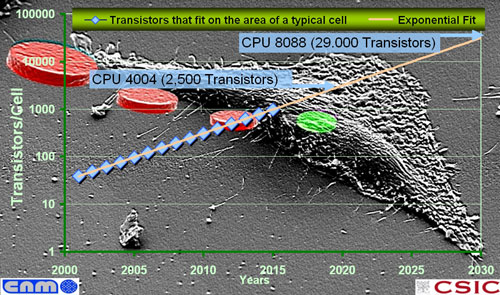 Nanowerk reports that researchers at the Micro and Nanosystems Department, Instituto de Microelectrónica de Barcelona have recently demonstrated that it is possible to produce and place small silicon chips inside living HeLa cells by means of different techniques, like lipofection, phagocytosis or microinjection. 90% of the cells remained alive and healthy for a week.
Nanowerk reports that researchers at the Micro and Nanosystems Department, Instituto de Microelectrónica de Barcelona have recently demonstrated that it is possible to produce and place small silicon chips inside living HeLa cells by means of different techniques, like lipofection, phagocytosis or microinjection. 90% of the cells remained alive and healthy for a week.
We’re talking about quite ordinary (but extraordinarily small) silicon chips that are made of a normal semiconductor material and produced by usual manufacturing methods. The chips can be used as intracellular sensors and the possibilites are endless — e.g., characterization, quantification and IRT monitoring of molecular processes at the single cell level.
This sounds like a promising route for molecular medicine. But it’s a potential nightmare for future medical museum curators. Good old steampunk medicine was about surgical instruments that operated on the level of visible organs. Now we’ve got a double problem: not only do we have to collect and preserve invisible cell-lines, but also take care of their invisible chips.
Does this mean the end of medical museum collections as we know them? Has anybody got a good idea for how to collect, preserve and display these creatures?
medical technologyrecent biomed
Is this the death of the science/medical museum collections as we know them?
Nanowerk reports that researchers at the Micro and Nanosystems Department, Instituto de Microelectrónica de Barcelona have recently demonstrated that it is possible to produce and place small silicon chips inside living HeLa cells by means of different techniques, like lipofection, phagocytosis or microinjection. 90% of the cells remained alive and healthy for a week. We’re talking about […]


